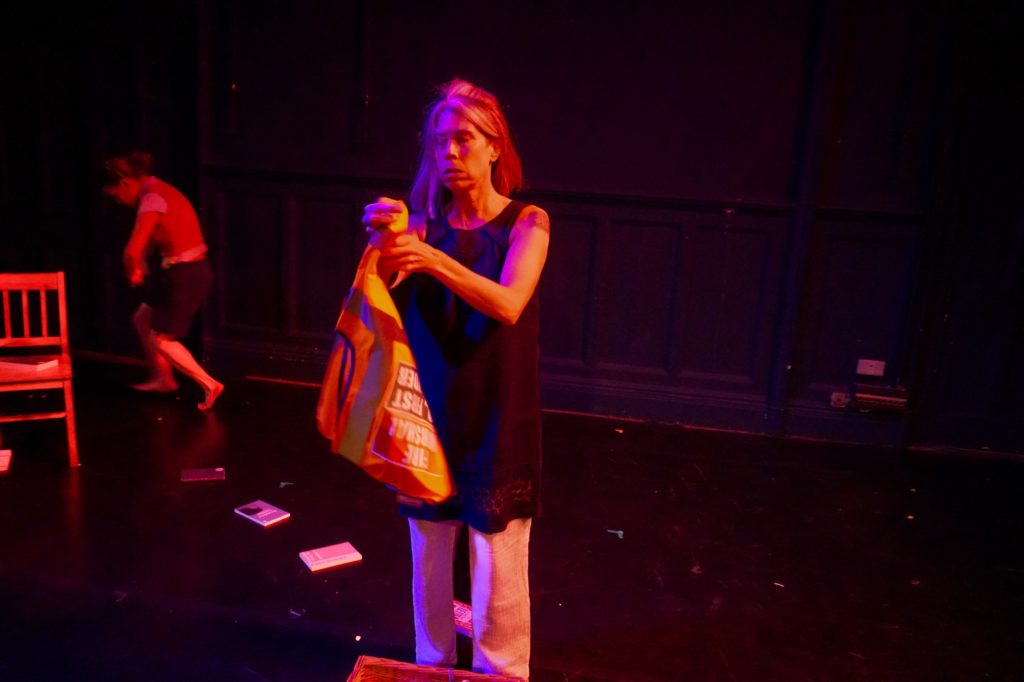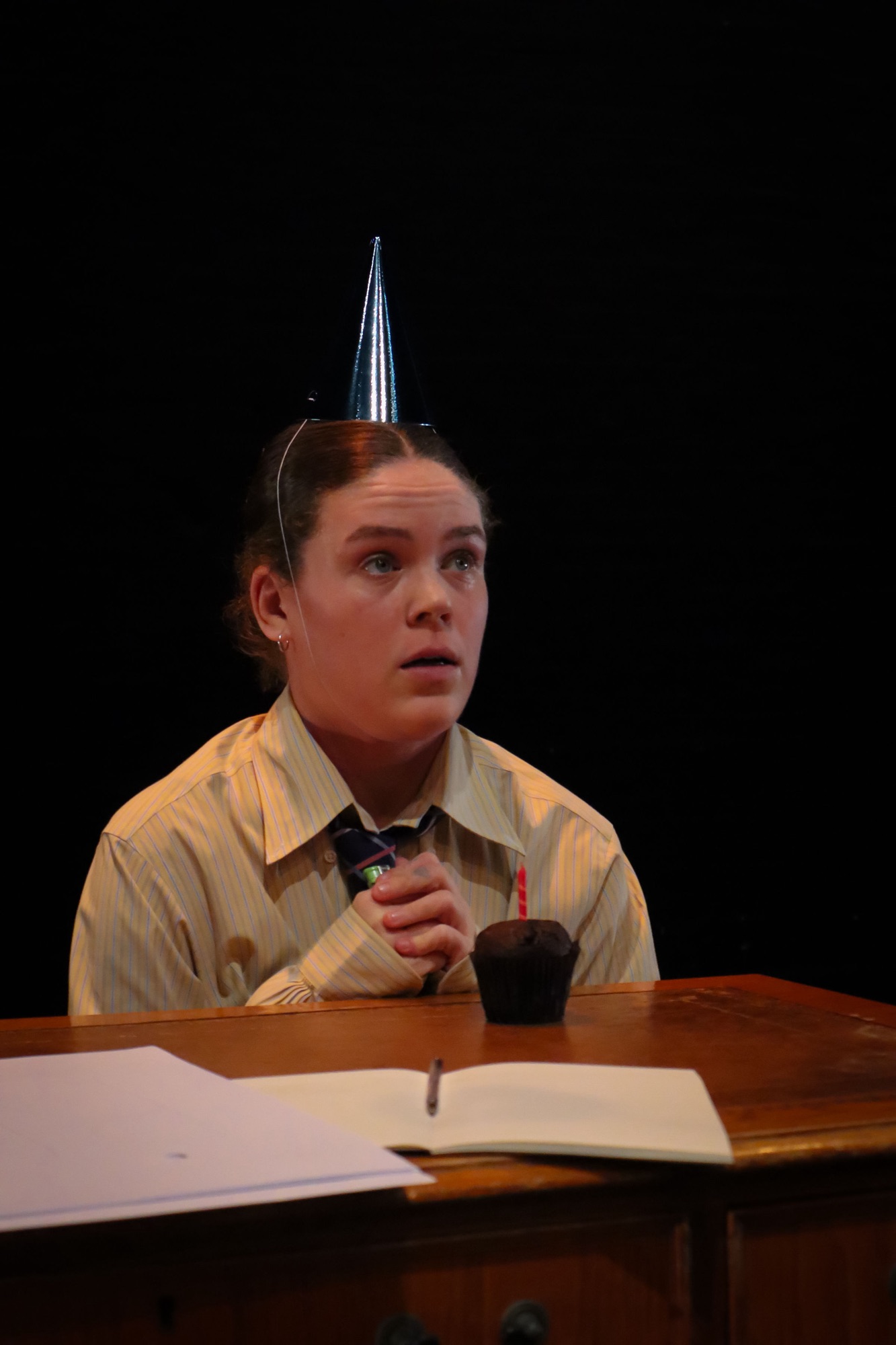Words by Pranita Choudhry. A double bill performed at Camden Fringe 2024.
The repetition, the loop, the frustration; these are what stayed with me after watching the Agony of Definition, a dance theatre piece by Kitty Pilgrim-Morris’ company Red Patch Productions at this year’s Camden Fringe. Pilgrim-Morris plays Claybourne, a doomed character always stuck in a state of replay who wishes to tell us something but just can’t seem to remember what it is!
The show begins with Claybourne quietly seated at their desk scribbling away in the darkness. When the lights come on, we zoom into their cubicle, as if viewing through a peephole. We see Claybourne in a costume and a setting resembling someone in an office or 9-5 job, except, strangely, their pants run up to their knees.
After witnessing Claybourne repeat the same set of moves for the fifth time and hearing the dialogue: ‘This is the same place you found me last time!’ with an enthusiastic smile, solidifies the rut. And then it began! A desperate search to remember, pacing, trying to convey something, seeking, looking, picking out numerous sheets with ideas scattered everywhere. ‘Less words’, ‘Cooler’, were some words written and displayed in the act, with no necessary logical link, only the madness to somehow make sense of it.
The huge enthusiasm from the beginning of the routine soon turns fierce, as we go deeper into the mindset of the character, aptly accompanied by a great selection of music tracks. The music intensifies and Clayborne slips into a state of intense internal reflection, dancing passionately and vigorously through their most confused state.
Their confusion is clear, at one point Claybourne is dancing in cool beach outfit with sunglasses, and soon after, abruptly, sits at their desk blowing out a candle on a cupcake making a wish. Every time they blow out that candle, they stare at the audience, as if wishing for it all to go away, but it just will not! The outcome remains the same.
This disruption, disorientation, lack of change made me jump out, feeling the agony in my own self, thinking back to all the times when I was confused, rattled, inarticulate. And then came the dip, Claybourne was calm and silent and even more repetitive. The chaos ends and things settle, almost as if Claybourne accepting that maybe things won’t change, maybe in the end, it’ll all be the same. They begin putting all the things back to where they were, as if getting back to reality and gathering the energy and spirit to do it all over again tomorrow.
Kitty Pilgrim-Morris breathed life into Claybourne’s character with their ballet and contemporary technique, their comic timing, as well as their fluent storytelling. The music scores added the drama and the lighting supported the ambitions of the work. Pilgrim-Morris’ portrayal of a character, a solo act that is erratic, disoriented, and confused is a handful, yet the artist does not disappoint. She holds the audience through the different phases of Claybourne’s life of ‘seeking’, ‘confusion’, ‘reflection’ through movement, dialogue and action, and concludes it with ‘acceptance’, possibly of the fact that things might change another day, just not today!

The next work in the double bill is Daughtered, the journey of a mother and daughter, a deep love that is imperfect yet constantly measured against unrealistic, unimaginable standards. This piece questions what does it really mean to be a mother: Who suffers, who thrives, and under what circumstances? Does this kind of love have any limits? Can it cross any lines, both for the mother and her child? What are the lines? What about the sea of care responsibilities that almost drown mothers? Some of these questions arise when Sharon (playing mother) hugs Kitty (playing daughter) at the start of the piece, beginning as a normal fond hug but soon feels like a strangle.
Sharon performs multiple tasks, as a chef, nurse, caretaker, fairy, super heroine, and bears all the exhaustion and tiredness, but more gravely also loses sight of who she is. It questions the expectations we put on mothers, to be experts in all fields and beautifully depicts when the only way Kitty can play is if Sharon continues her multiple roles. It begs the question if mothers can indeed protect their children under all circumstances, through Keesa’s tragedy – a story drawn from one of Kitty’s books. It is about a mother who receives saintly advise that the only way to save her child from illness and death is if she is able to find mustard seeds from a household in her village where death has yet to occur. She doesn’t and blames herself, but could she have done more?
The piece is also about identity and identity shifts, with Sharon expressing her confusion as a young woman thinking the only way she can address all her problems is to become a mom. But soon, she finds herself steeped in responsibilities to create a comfortable, loving, secure world for her child, but is still seeking. On the other hand, even though her daughter feels loved, she also feels grief, fear, insecurity, of being abandoned, all whilst figuring out who she is in the process.
Sharon and Kitty, a mother daughter duo take us through a journey of how complex, convoluted, imperfect, and challenging the relationship is by design. Through their skillful storytelling, singing, movement and expressions, they truly held the space and captivated our attention. In the end, despite her multiple roles and burdens, Sharon paves the way for her daughter laying out books as if a pathway to the forest, and reassures her child that even though she might someday feel abandoned and lost, the trees will help her find the way. Like mothers do, she somehow finds the wisdom and strength to continue, even if she doesn’t have all the answers.
